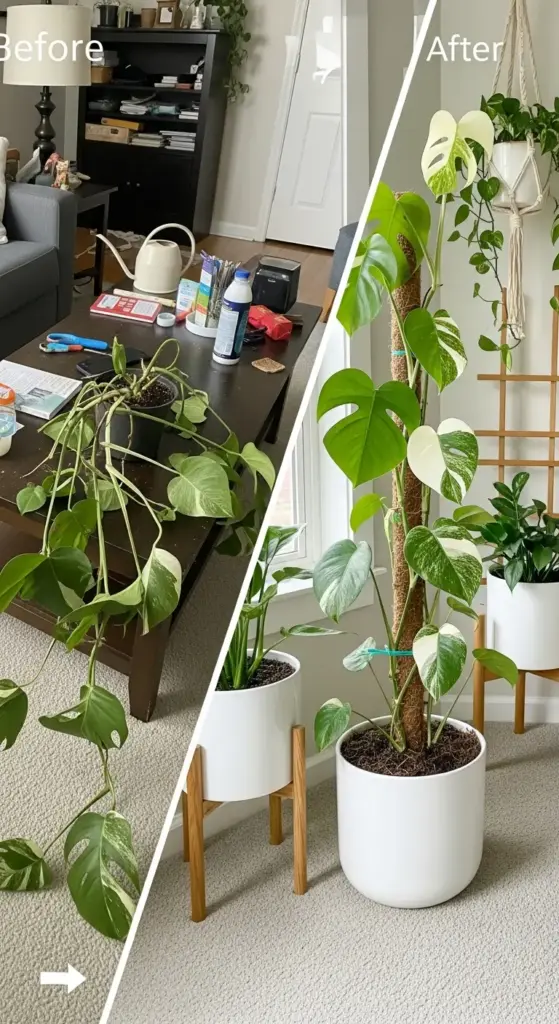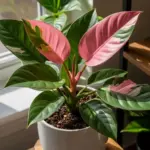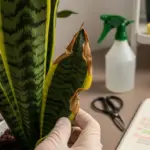5. Support and Train Your Plant for That Designer Look

My Monstera variegata used to look like a hot mess – sprawling all over my coffee table with tiny leaves that barely showed any variegation. I thought that’s just how they grew indoors.
Then I saw a friend’s plant climbing a moss pole with massive, fenestrated leaves and realized I’d been doing everything wrong. Support isn’t optional – it’s essential for that designer specimen look.
The transformation after adding proper support was honestly shocking. Within six months, my leaf size doubled and the variegation became way more dramatic.
Moss Pole Installation That Actually Works
Moss pole setup intimidated me for months because I was afraid of damaging my expensive plant. Turns out, it’s way easier than I thought.
I use 3-foot sphagnum moss poles from Amazon – they’re like$15 and work better than the fancy coco fiber ones I tried first.
The trick is installing it when you repot so you’re not disturbing established roots. I position the pole slightly off-center, toward the back of the pot.
Soaking the moss pole before installation helps it hold moisture and encourages aerial root attachment. I soak mine for about 30 minutes.
Trellis Options for Different Spaces
Not everyone has room for tall moss poles. Bamboo trellises work great in smaller spaces and cost way less than specialty plant supports.
I’ve used everything from tomato cages to decorative wooden trellises. The key is making sure they’re sturdy enough for a mature plant.
Metal plant stakes with clips work too, but they don’t encourage the natural climbing behavior that produces those massive leaves.
For apartments with low ceilings, I use shorter supports and train the plant horizontally along a wall-mounted trellis.
Pruning for Fuller, Bushier Growth
This was probably my biggest mental hurdle – cutting my expensive plant felt like destroying money. But strategic pruning actually increases your plant’s value.
I prune right above a node during growing season, usually in spring or early summer. Each cut encourages the plant to branch out instead of just growing taller.
Leggy growth with small leaves gets the chop first. Those weak stems rarely produce good variegation anyway.
I always use clean, sharp scissors and make cuts at a 45-degree angle about a quarter-inch above the node.
Propagation: Multiplying Your Investment
Here’s where pruning pays off literally – those propagation cuttings can be worth$50-200 each depending on the variegation.
Each cutting needs at least one node and preferably an aerial root. I’ve successfully propagated cuttings with just nodes, but aerial roots make it way easier.
Water propagation works, but I get better results rooting directly in my soil mix. Takes about 4-6 weeks to see new growth.
I keep propagation containers in the same conditions as the mother plant – bright indirect light and consistent humidity.
Training Aerial Roots Like a Pro
Aerial root management was confusing until I realized they’re basically the plant’s way of climbing in nature. Don’t cut them off!
I gently guide aerial roots toward the moss pole using soft plant ties. Never force them – they’ll attach naturally when they’re ready.
Misting aerial roots helps them attach to supports faster. I spray them lightly every few days during growing season.
Some people tuck aerial roots back into the soil, but I prefer letting them climb for that authentic jungle look.
Creating Instagram-Worthy Plant Displays
Plant styling is honestly half the fun of growing these beauties. I’ve learned a few tricks that make my setup look way more expensive than it actually is.
Matching planters make a huge difference. I bought three identical white ceramic pots and grouped my plants together for maximum impact.
Height variation creates visual interest – I use plant stands and hanging planters to create layers in my plant corner.
Good lighting for photos matters too. I position my plants near my biggest window for those perfect morning light shots.
Staking Without Stem Damage
Gentle staking techniques took me forever to master because I kept using ties that were too tight or rough materials.
Soft fabric ties or velcro plant ties work way better than wire or string. I learned this after accidentally cutting into a stem with wire ties.
Loose attachment is key – the tie should support without restricting growth. I check and adjust ties monthly as the plant grows.
I stake new growth when it’s still flexible, usually within the first few weeks after a new leaf unfurls.
Timing Your Training Sessions
Plant training works best during active growing season when the plant can quickly adapt to changes. I do most of my major work in spring.
Winter training usually backfires because the plant is focused on survival, not adapting to new support structures.
I make small adjustments year-round but save big changes like new moss poles or major pruning for March through August.
Consistent small adjustments work better than dramatic changes all at once. Your plant needs time to adapt.
Support Maintenance and Upgrades
Moss pole maintenance is something nobody talks about but it’s crucial for long-term success. I replace mine every 2-3 years when they start breaking down.
I’ve learned to buy taller poles than I think I need because these plants grow faster than expected once they start climbing.
Upgrading support systems as your plant matures is part of the journey. What works for a young plant won’t support a massive specimen.
I keep spare ties and stakes on hand because supports need adjustments as the plant grows and seasons change.
Conclusion
Growing a Monstera variegata that rivals those $500 specimens isn’t just about following basic plant care – it’s about understanding the nuanced needs of these incredible plants and creating an environment where they can truly flourish.
By mastering light placement, perfecting your watering routine, maintaining proper humidity, choosing the right soil, and providing adequate support, you’re not just caring for a houseplant.
You’re cultivating a living piece of art that transforms your space and potentially your bank account! Remember, every plant parent’s journey is unique, so don’t be afraid to adjust these tips based on your specific living situation and climate.
Your future self (and your Instagram followers) will thank you when your Monstera becomes the envy of every plant lover in your city!









GIPHY App Key not set. Please check settings